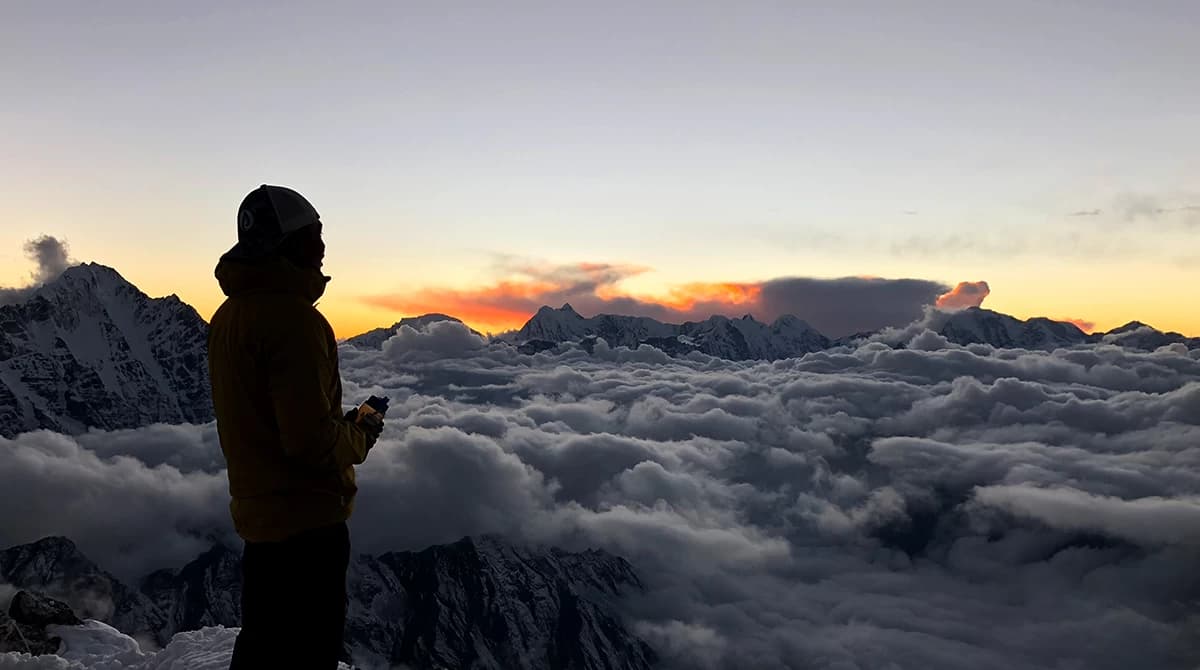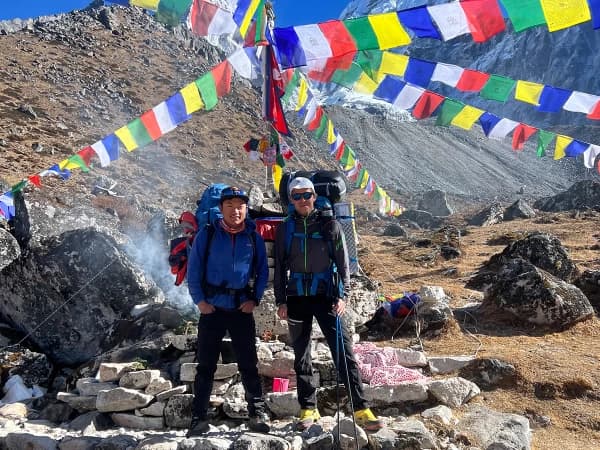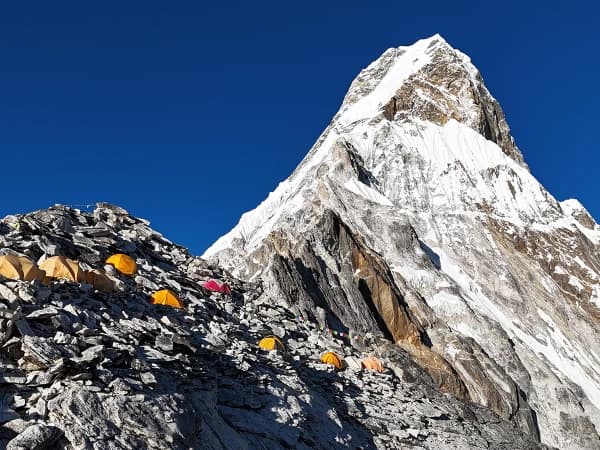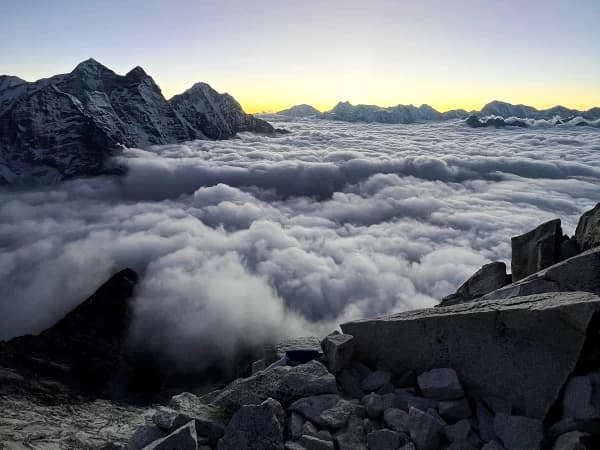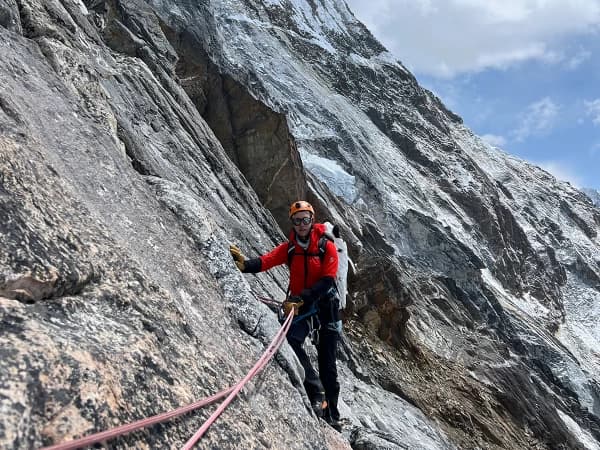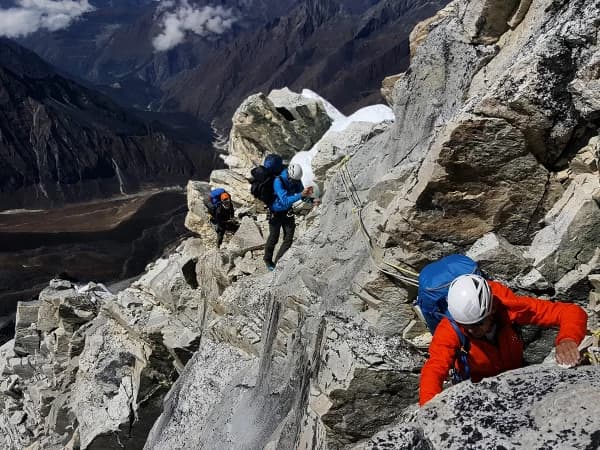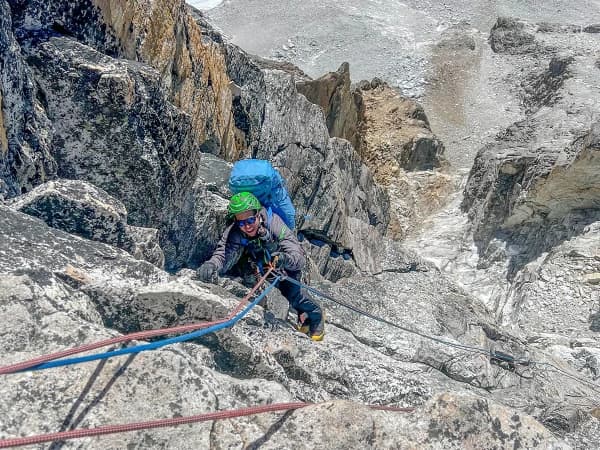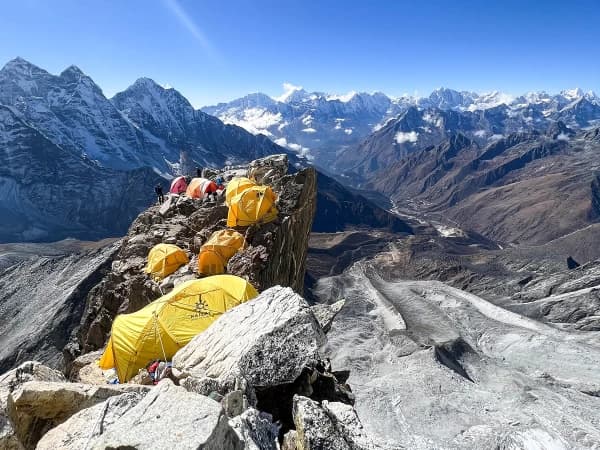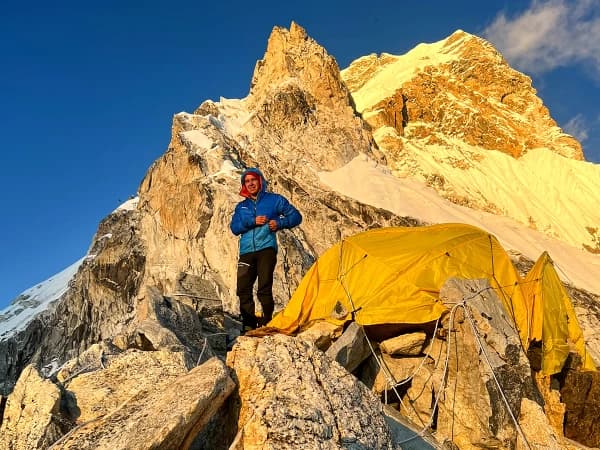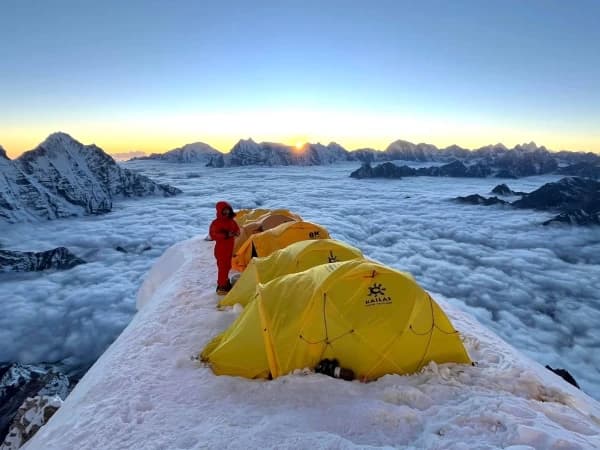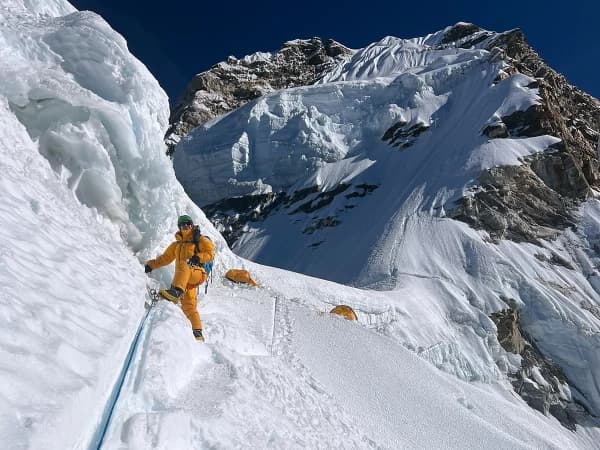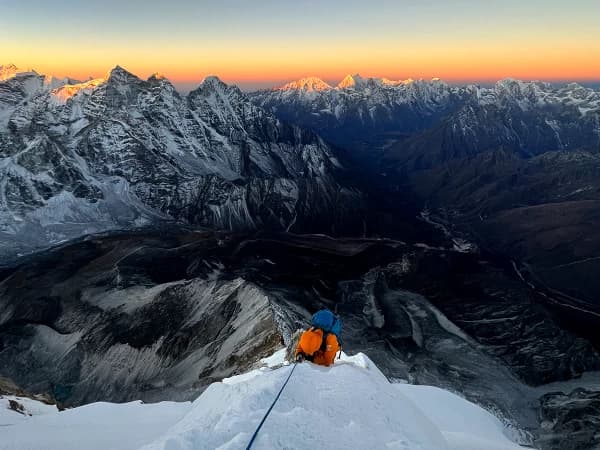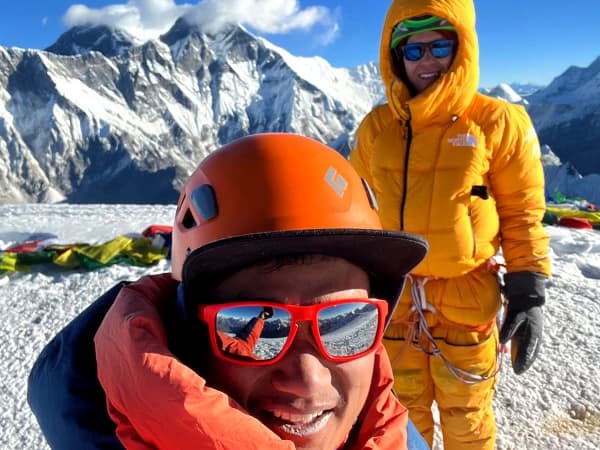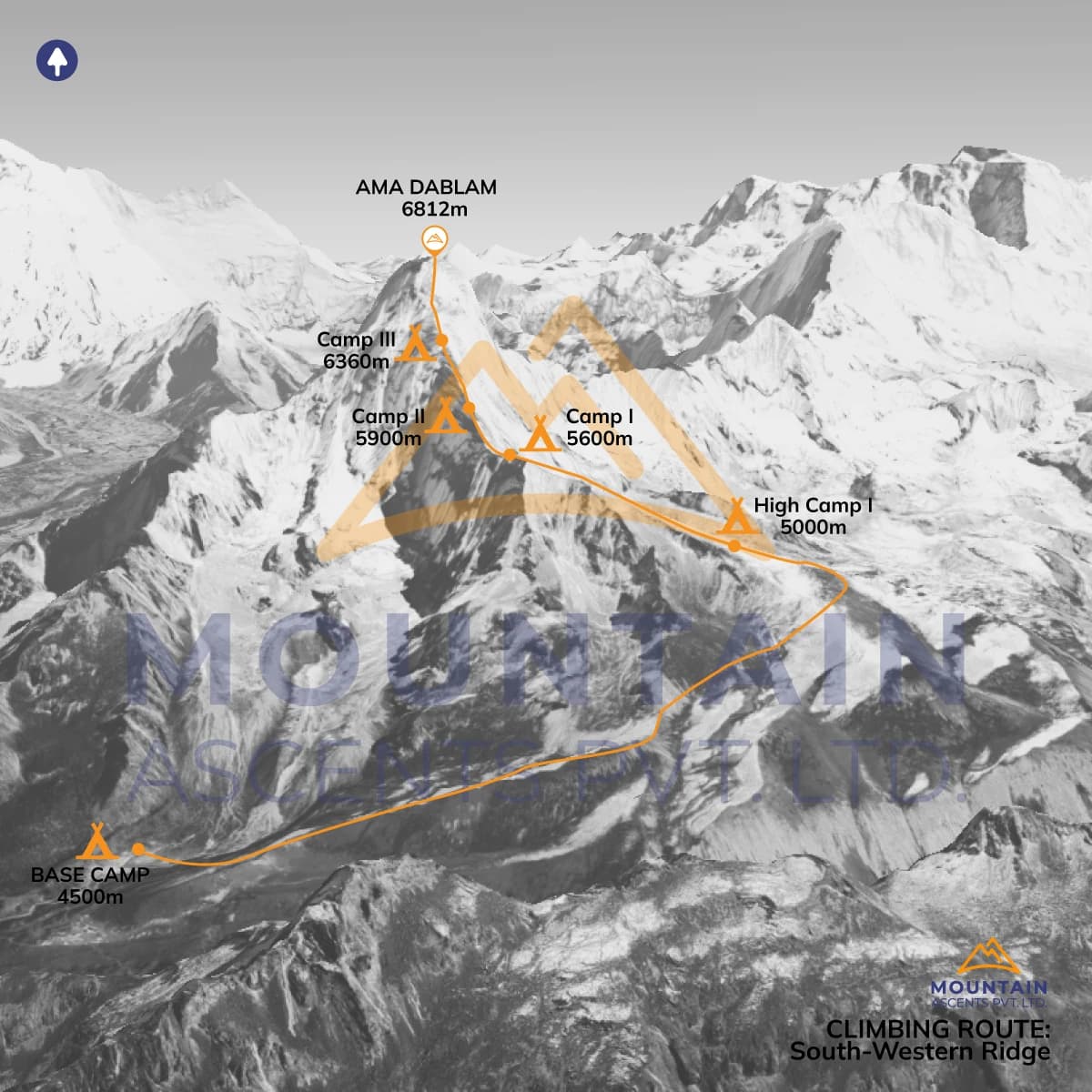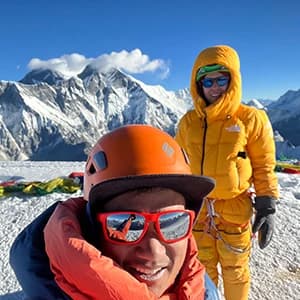The Lobuche Peak Climbing - Ama Dablam Combo is an ultimate Himalayan climbing journey to the Khumbu/Everest Himalayas of Nepal, specially designed for mountaineers looking forward to experiencing two of the iconic Himalayan giants in one single trip. Nestled in the heart of Nepal’s Khumbu region at an altitude of Lobuche Peak at 6,119 m and Ama Dablam at 6,812 m above sea level, these peaks represent both technical challenge and natural beauty in the unspoiled landscape for you to explore.
Starting with an epic trek entering deep into the legendary Khumbu Valley, this Himalayan voyage is in trend for Ama Dablam’s graceful yet formidable presence with some more technical section than in Lobuche, which draws attention for its distinctive allure, promising an exciting ascent for those seeking the summit. The caravan routes take you past the alluring landscapes of Lukla, Phakding, and Namche Bazar before continuing deeper into the Himalayas. Trekking through amazing communities and challenging terrain will allow you to see the region's rich wildlife, which includes secretive snow leopards and majestic Himalayan yaks.
Over 30 days of adventure, you'll travel through a variety of places, from lush valleys to stunning mountain passes. Every day brings new challenges and rewards as you progress toward your ambitious goals. With an average walking time of 5-6 hours per day, you'll have plenty of time to immerse yourself in the beauty of the Himalayan wilderness. Experienced guides will accompany you throughout the trip, sharing their knowledge and ensuring your safety at all times.
Join Mountain Ascents on this amazing trek, where the spirit of adventure meets the grandeur of the Himalayan range. Experience the beauty of Lobuche and Ama Dablam while making memories that last for a lifetime.
Trip Highlights
- Visit the UNESCO World Heritage Sites in the Kathmandu Valley.
- Enjoy a quick yet scenic flight to and from Lukla, the gateway to the Everest region.
- Trek through the center of the stunning Khumbu Valleys, rivers, cascading waterfalls, and natural beauty.
- Experience exciting suspension bridges, traditional settlements, dense green forests, and stunning views of the surrounding Everest Himalayas along the Dudh Koshi River.
- Hike through the alpine Himalayas to summit two of the Nepalese Himalayan peaks above 6,000 m, Mt. Lobuche (6,119 m) and Mt. Ama Dablam (6,119 m).
- Experience authentic teahouses and camping on one single trip.
- Capture otherworldly sights of Mt. Everest, Lhotse, Ama Dablam, and Makalu from various viewpoints, especially from Mt. Lobuche and Ama Dablam.
- Get an insider insight into the customary life of Sherpa, famed as the tigers of snow for their incredible mountaineering skills and many more.
What makes the Lobuche Peak Climbing - Ama Dablam Combo Special?
The combined journey to Lobuche and Ama Dablam, mostly convenient for experienced trekkers and climbers aiming to tackle both the technical and high-altitude challenges in one go, is unique for various reasons. First of all, the combination of summits to two distinct Himalayan peaks where the Lobuche East acts as a warm-up for more technical Ama Dablam.
For several days you will walk 5-7 hours per day in the highly elevated Himalayan areas, allowing proper acclimatization, along with some days allocated solely for rest and exploration, which are also used for skill building and mental and physical preparation for the technical challenge to expect practice essential skills like managing ropes and navigating icy sections, and others as briefed below:
Amazing Himalayan views and unique Cultural experience
Awe-inspiring panoramas of the Himalayas, including Everest, Lhotse, Makalu, and others more spectacular, await you throughout the Lobuche-Ama Dablam expedition from the summits of Ama Dablam and Lobuche East, often regarded as the best in the Khumbu region. As you trek along the Khumbu Valley, featuring varied landscapes from dense woodland in the lower region to rugged glaciers and snowy alpine zones in the high altitude, each stage of the journey rewards you with something new and striking to marvel at.
On clear days, the summits of both Lobuche and Ama Dablam reveal mythical views of Khumbu Valley and beyond, with nearby peaks appearing almost touchable, added much by the cultural encounter of the Sherpa people, locals to the Himalayan region of Nepal. Known for their superhuman-like mountaineering skills, resilience, and cultural heritage, Sherpas are usually friendly and are happy to share their unique language, rich traditions, and Buddhist faith.
Throughout the expedition, it would be an enthralling memory to experience the authentic Sherpa way of life, visit ancient monasteries, and enjoy panoramic views of the sky—towering mountain ranges.
Dual peak achievement in the Everest/Khumbu region of Nepal
Much to the delight of adventurous spirits, the combined journey to Lobuche and Ama Dablam expedition allows climbers to summit both Lobuche East and Ama Dablam. Where Lobuche East Peak acts as an acclimatization climb, keeping you prepared for the higher and more technical climb to Ama Dablam near the popular Everest Base Camp Trekking route, southwest of Mount Everest, close to the village of Lobuche. The trail to here often consists of steep and rocky sections requiring basic technical climbing skills along with the use of fixed ropes.
Similarly, to the south of Everest and Lhotse, the journey to Ama Dablam, also called “Matterhorn of the Himalayas” for its distinctive pyramid shape and dramatic ridges, is more technical and characterized by its rock, snow, and ice climbing sections. Famous for its “Dablam” ice walls and ridges, expect to encounter fixed lines, exposed sections, and camps that reward you profoundly with the mythical sight of Mount Everest, Lhotse, Nuptse, and Makalu, along with Ama Dablam and a serene sense of achievement, adventure, and resilience.
The world-class Sherpa guidance
Along with Nepal banning free individual trekkers and travelers in its protected, restricted, and conserved areas since April 1st, 2023, which implies one must at least have local guides for essential permits, it is crucial to understand that a Sherpa guide for a combined expedition is an integral part of the journey.
The locals from the mountains provide valuable support to the summit, sharing their technical skills and in-depth knowledge of the terrain, ensuring safe navigation and successful ascents. While most of them are also well trained for alpine rambling and first aid, they also fill the cultural and language gap between you and the locals for a smoother experience.
On the way, professional Sherpa guides provide you with advice on required techniques, safety protocols, and local customs, making them a must-have expedition companion that we at Moutain Ascents also boast about.
A perfect practice ground for 7,000m+
Both the Lobuche and Ama Dablam Climbing routes, after trekking several days through the Sagarmatha National Park, offer mixed terrain, from lush green valleys and forests in the lower altitude teeming with wildlife to snowy, sharp, and rocky ridges that test climbers’ technical skills. The combo expedition features it all.
The expedition is more than 4 weeks long at high altitudes without pushing into the extreme ranges, allowing thorough acclimatization to lower oxygen levels; however, it is both physically and mentally demanding, which definitely adds a lot to the confidence level of the individual required for high peaks above 7,000 m and more on a successful ascent to Lobuche and Ama Dablam.
Therefore, Lobuche-Ama Dablam Combo Expedition is just the right destination to build up your technical foundation, mental strength, and high-altitude experience needed to pursue more ambitious and demanding 7,000 m+ and 8,000 m+ peaks such as Baruntse (7,129 m), Himlung (7,126 m), Mt. Manaslu (8,163 m, the eighth highest mountain peak in the world), and the tallest mountain peak on the earth itself, Mt. Everest (8,848 m).
An authentic Himalayan Adventure
Both the Lobuche and Ama Dablam are among some of the less traversed snowcapped peaks in the Everest Region in comparison to Mera Peak and Island Peak, which diverge the route from massively populated Everest Base Camp Trekking Trails from Namche Bazaar, providing a more authentic and solitary experience.
The route takes you through charming Sherpa villages, including Lukla, Phakding, Namche Bazar, Dole, Machhermo, Gokyo, and Dragnag. These traditional villages are not only beautiful but are the heart of Sherpa culture and hospitality, added much by the visit to Buddhist monasteries usually adorned with vibrant prayer flags.
Along the way, trekkers and climbers get to experience the unparalleled genuine hospitality of the Sherpa community, the backbone of Everest climbing, trekking, and expedition. They offer traditional food and accommodation in the tea house and are friendly hosts keen to share their culture, often tempting visitors to visit Nepal back and forth.
Similarly, the mode of accommodation transits from base camps onwards to camping, offering unmatched wilderness when you will spend nights amidst the tranquil setting surrounded by snow-covered mountain peaks and stars in the blue sky, promising you an intimate journey through the culture, traditions, and natural splendor of the Himalayas.
Why the 30-day itinerary is the best route for a combined expedition to Lobuche and Ama Dablam?
The 30-day itinerary for the Lobuche-Ama Dablam Combo Expedition begins with your landing on the capital city of Nepal, Kathmandu, with at least seven cultural, religious, and historical landmarks such as Pashupatinath Temple, Boudhanath, and others. The second day is for trip preparation, while the journey officially takes initiation on the third day with a mountain flight to Lukla from Kathmandu. The third day is also when you will start the trek in the majestic Khumbu region of Nepal, which calls it a day in Phakding for the night. The Himalayan voyage thereafter makes its way to Lobuche Peak from Namche Bazaar after an acclimatization day that goes through Dole, Machhermo, Gokyo, Dragnag, and Dzongla, eventually making it to the base camp and Lobuche Peak at last on the 13th day.
However, the trip does not conclude here; rather, it's the beginning of yet another adrenaline-rushing Himalayan Odyssey towards Ama Dabla with a leg day stopping at the Ama Dablam Base Camp at an altitude of 4,600 m/15,100 ft, where you will spend at least two nights for resting, preparation, and camp rotation that aids a lot in migrating the acute mountain sickness (AMS). Considering the fickle Himalayan weather, 16–25 days are allocated as a climbing period while you will retrace the route back to Namche, Lukla, and Kathmandu from 26 days onwards. Nonetheless, as the 30-day itinerary allows ample acclimatization days, it lets you maintain your pace and prepare climbers for Ama Dablam’s higher, more technical ascent with a summit to Lobuche.
Further, the itinerary is also designed carefully, putting consideration to the unpredictable Himalayan weather separating summit windows so you make it safely and soundly to the summit. In addition, Mountain Ascents is also flexible to customize the itinerary as per your needs and preferences, ensuring a more enjoyable and well-supported experience; hence, it is considered the best route even for 2025 and 2026.
How much does it cost for the Lobuche-Ama Dablam Combo Expedition?
The exact cost to go for Lobuche-Ama Dablam Climbing can vary greatly depending on several factors, such as the itinerary you have chosen for yourself, the type of organizer you are travelling with, the service included and excluded, along the season locally based. Mountain Ascents is at the edge for the best competitive price and is good to budget USD 7,000 to USD 10,500 per person.
Our Lobuche-Ama Dablam Combo Expedition package cost covers expenses for essential trekking and climbing logistics, including guides, permits, day-to-day meals, accommodation in tea houses and camps when needed, salary, travel insurance, and gear and equipment for Nepalese staff as well, ensuring your hassle-free journey. Contact us now for a special discount on mountaineer groups of more than 10 members!


